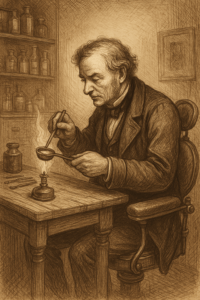Once upon a time, your local dentist might have poisoned you—accidentally, of course.
The Curse of the Lead Tooth Fillings
Before the age of composites, ceramics, and scientifically tested amalgams, dentistry was equal parts art and experiment. Early practitioners often mixed their own materials, melted metals over open flames, and tried whatever seemed to seal a cavity and stop the pain. Among their earliest “solutions” for decayed teeth was a simple, heavy metal we now recognize as dangerously toxic: lead.
These early lead tooth fillings were crude yet surprisingly common in both Europe and colonial America, long before the chemistry of dental materials was understood. It seemed like a miracle at the time—lead was soft, easy to mold, and widely available. It sealed a tooth so effectively that the pain might vanish overnight. Unfortunately, so would the patient’s long-term health.
From Pipes to Plombage
The use of lead in dentistry dates back to antiquity. The Romans used it extensively in plumbing (the Latin word plumbum means lead), cooking vessels, and even cosmetics. So when cavities appeared, lead seemed a logical, malleable filler material. It was easy to melt, shape, and tamp into a tooth—qualities that made it, unfortunately, too convenient.
Ancient craftsmen described heating small pellets of lead and packing them into cavities using bone or ivory tools. Relief was often immediate, and for centuries no one suspected the danger. The same substance that carried Rome’s water supply and sweetened its wine was quietly leaching toxins into people’s mouths.
In French, plomb means “lead,” and the word for a dental filling is plombage. German uses Plombe, and Polish adopted plomba. All derive from the same Latin root. Even the English word plumber shares this lineage—literally, a worker in lead. The connection between sealing pipes and sealing teeth wasn’t just linguistic; it was professional practice.
 Deadly Dentistry
Deadly Dentistry
Lead’s toxicity wasn’t fully understood until the late nineteenth century, but its effects were insidious. Chronic exposure caused anemia, cognitive decline, digestive disorders, tremors, and even infertility. Patients who received lead tooth fillings might not have realized their dental treatment was slowly poisoning them, creating a silent epidemic of metal toxicity.
Dentists themselves were sometimes the first casualties. Those who melted lead daily in close quarters inhaled fumes without realizing the risk. One eighteenth-century practitioner recorded “a trembling of the hands and weakness of the mind” after years of restorative work—what we would now recognize as lead poisoning.
From Lead to Amalgam—A New Controversy
When mercury-based amalgam replaced lead in the 1830s, it was hailed as a safer, more durable material. Yet the Amalgam Wars that followed showed how controversial dental materials can be. Lead had poisoned quietly; mercury’s toxicity was more debated but no less real. Each generation of dentistry, it seems, faces its own “curse” of unintended consequences. What begins as progress often reveals hidden costs a century later.
Echoes of Lead Tooth Fillings in Modern Materials
Today, dental composites and ceramics are rigorously tested for biocompatibility, and toxic metals are long gone from practice. Still, the story of lead tooth fillings reminds us that even well-intentioned science can carry unseen risks until knowledge catches up.
Archaeologists occasionally find traces of those early restorations. CT scans of ancient skulls reveal bright metallic specks inside molars—tiny signatures of humanity’s ongoing trial-and-error approach to health. Each one is a message from the past: innovation always comes with a price.
The Linguistic Legacy of Lead
In Polish, the word ołów means lead, while plomba means filling. The latter traces back through German and French, connecting dentistry across Europe to the same metallic root. The shared etymology is a linguistic fossil, a reminder that our language—and our teeth—carry the imprint of history.
The Dark Side of Dental Progress
Looking back, the use of lead in fillings feels unthinkable—but it’s a reminder that progress often comes with shadows. Dentistry’s evolution, like all science, is written in trial and error. Each discovery leaves behind its relics, and sometimes, its curses. From lead to mercury to modern composites, every breakthrough reflects humanity’s determination to heal, even when the materials themselves fight back.
The story of lead tooth fillings is both a warning and a tribute to human persistence. Even when our methods were flawed, the goal—to preserve a tooth, to relieve pain, to restore a smile—remained the same. In that sense, the metal may have been heavy, but the intent was noble.
To explore more of these strange turning points, visit our Weird Dental Facts archive.
Further Reading:
Author: Dr. Richard Walicki, DMD | ToothWiz Health





